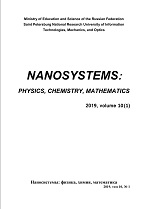|
Thermally induced transitions and minimum energy paths for magnetic systems
E. V. Alexandrov
ITMO University, St. Petersburg, Russia
Abstract:
Thermally induced magnetic transitions are rare events as compared with vibrations of individual magnetic moments. Timescales for these processes differ by 10 orders of magnitude or more. Therefore, the standard Monte-Carlo simulation is not suitable for the theoretical description of such phenomena. However, a statistical approach based on transition state theory is applicable for calculations of the transition rates. It presupposes finding the minimum energy path (MEP) between stable magnetic states on the multidimensional energy surface of the system. A modification of the Nudged Elastic Band (NEB) method for finding the energy barriers between states is suggested. A barrier on the energy surface corresponds to the difference between maximum energy along the MEP (highest saddle point) and the initial state minimum. The NEB procedure is implemented for spin rotations in Cartesian representation with geometric constraint on the magnitude of the magnetic moment. In this case, the effective magnetic forces are restricted to the tangent plane of the magnetic momentum vector.
Keywords:
Potential energy surface, minimum energy path, nudged elastic band method, numerical optimization, quick min-mode.
Received: 31.12.2014
Citation:
E. V. Alexandrov, “Thermally induced transitions and minimum energy paths for magnetic systems”, Nanosystems: Physics, Chemistry, Mathematics, 6:1 (2015), 57–62
Linking options:
https://www.mathnet.ru/eng/nano919 https://www.mathnet.ru/eng/nano/v6/i1/p57
|

|




 Contact us:
Contact us: Terms of Use
Terms of Use
 Registration to the website
Registration to the website Logotypes
Logotypes








 Citation in format
Citation in format 